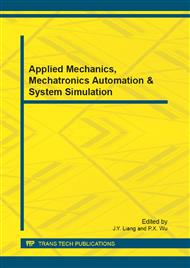[1]
Cancer Research UK. Breast cancer factsheet; February (2004).
Google Scholar
[2]
NationalCancer Institute ofCanada. Canadian cancer statistics 2006; (2006).
Google Scholar
[3]
Alfonso Rojas Domínguez, Asoke K, NandiToward breast cancer diagnosis based on automated segmentation ofmasses inmammograms, Pattern Recognition 42 (2009) , 1138-1148.
DOI: 10.1016/j.patcog.2008.08.006
Google Scholar
[4]
Encarnacao JL, Peitgen H-O, Sakas G, Englert G. Fractal geometry and computer graphics. Berlin: Springer-Verlag; (1992).
Google Scholar
[5]
Caldwell CB, Stapleton SJ, Holdsworth DW, Jong RA, WeiserWJ, Cooke G, et al. Characterization of mammographic parenchymal pattern by fractal dimension. Phys Med Biol, 1990; 35: 235-47.
DOI: 10.1088/0031-9155/35/2/004
Google Scholar
[6]
Bruce LM, Adhami RR. Classifying mammographic mass shapes using the wavelet transform modulus-maxima method. IEEE Trans Med Imag 1999; 18(12): 1170-7.
DOI: 10.1109/42.819326
Google Scholar
[7]
Homer MJ. Imaging features and management of characteristically benign and probably benign lesions. Radiol Clin N Am 1987; 25(5): 939-51.
DOI: 10.1016/s0033-8389(22)02273-4
Google Scholar
[8]
Homer MJ. Breast imaging: pitfalls, controversies and some practical thoughts. Radiol Clin N Am 1985; 23(3): 459-72.
Google Scholar
[9]
Mavroforakis M, Georgiou H, Dimitropoulos N, Cavouras D, Theodoridis S. Significance analysis of qualitative mammographic features, using linear classifiers, neural networks and support vector machines. Eur J Radiol 2005; 54: 80-9.
DOI: 10.1016/j.ejrad.2004.12.015
Google Scholar
[10]
Z.M. Huo, M.L. Giger, C.J. Vyborny, D.E. Wolverton, R.A. Schmidt,K. Doi, Automatedcomputerized classification of malignant and benign masses on digitized mammograms, Acad. Radiol. 5 (1998)155-168.
DOI: 10.1016/s1076-6332(98)80278-x
Google Scholar
[11]
N. Petrick, H.P. Chan, B. Sahiner, M.A. Helvie, Combined adaptiveenhancement and region-growing segmentation of breast masses on digitized mammograms, Med. Phys. 26 (1999) 1642–1654.
DOI: 10.1118/1.598658
Google Scholar
[12]
N.M. El-Faramawy, R.M. Rangayyan, J.E.L. Desautels, O.A. Alim, Shape factors for analysis of breast tumors in mammograms, 1996 Canadian Conference on Electrical and Computer Engineering, 1996, p.355–358.
DOI: 10.1109/ccece.1996.548110
Google Scholar
[13]
N. Petrick, H.P. Chan, B. Sahiner, M.A. Helvie, Combined adaptive enhancement and region-growing segmentation of breast masses on digitized mammograms, Med. Phys. 26 (1999) 1642–1654.
DOI: 10.1118/1.598658
Google Scholar
[14]
B. Sahiner, H.P. Chan, N. Petrick, D. Wei, M.A. Helvie, D.D. Adler M.M. Goodsitt, Classification of mass and normal breast tissue: a convolution neural network classifier with spatial domain and texture images, IEEE Trans. Med. Imaging 15 (5) (1996).
DOI: 10.1109/42.538937
Google Scholar
[15]
B. Sahiner, H.P. Chan, N. Petrick, M.A. Helvie, M.M. Goodsitt, Design of a high-sensitivity classifier based on a genetic algorithm: application to computer-aided diagnosis, Phys. Med. Biol. 43 (10)(1998) 2853–2871.
DOI: 10.1088/0031-9155/43/10/014
Google Scholar
[16]
F.F. Yin, M.L. Giger, K. Doi, C.J. Vyborny, R.A. Schmidt, Computerized detection of masses in digital mammograms: investigation of feature-analysis techniques, J. Digital Imaging 7(1994) 18–26.
DOI: 10.1007/bf03168475
Google Scholar
[17]
K. Bovis, S. Singh, J. Fieldsend, C. Pinder, Identification of masses in digital mammograms with MLP and RBF nets, in: Proceedings of the IEEE-INNS-ENNS International Joint Conference on Neural Networks Com, 2000, p.342–347.
DOI: 10.1109/ijcnn.2000.857859
Google Scholar
[18]
B. Sahiner, N. Petrick, H.P. Chan, Computer-aided characterization of mammographic masses: accuracy of mass segmentation and its effects on characterization, IEEE Trans. Med. Imaging 20 (12)(2001) 1275–1284.
DOI: 10.1109/42.974922
Google Scholar
[19]
B. Sahiner, H.P. Chan, N. Petrick, M.A. Helvie, M.M. Goodsitt, Design of a high-sensitivity classifier based on a genetic algorithm: application to computer-aided diagnosis, Phys. Med. Biol. 43 (10)(1998) 2853–2871.
DOI: 10.1088/0031-9155/43/10/014
Google Scholar
[20]
J.R. Koza, Genetic Programming: On the Programming of Computers by Means of Natural Selection, MIT Press, Cambridge, (1992).
Google Scholar
[21]
Koza, John R. Genetic Programming . Cambridge, MA: MIT Press, (1992).
Google Scholar
[22]
J Suckling et al (1994): The Mammographic Image Analysis Society Digital Mammogram Database Exerpta Medica. International Congress Series 1069 pp.375-378.
Google Scholar
[23]
Alfonso Rojas Dom´ ınguez, Asoke K. Nandi, Detection of masses in mammograms via statistically based enhancement, multilevel-thresholding segmentation, and region selection, Computerized Medical Imaging and Graphics 32 (2008) 304–315.
DOI: 10.1016/j.compmedimag.2008.01.006
Google Scholar
[24]
Pasquale Delogu, Maria Evelina Fantacci, Parnian Kasae, Alessandra Retico, Characterization of mammographicmasses using a gradient-based segmentation algorithmand a neural classifier, Computers in Biology and Medicine 37 (2007) 1479 – 1491.
DOI: 10.1016/j.compbiomed.2007.01.009
Google Scholar


